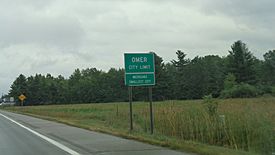Omer, Michigan facts for kids
Quick facts for kids
Omer, Michigan
|
|
|---|---|
| City of Omer | |

Signage along U.S. Highway 23
|
|

Location within Arenac County
|
|
| Country | United States |
| State | Michigan |
| County | Arenac |
| Settled | 1866 |
| Incorporated | 1903 |
| Government | |
| • Type | Council–manager |
| Area | |
| • Total | 1.16 sq mi (3.00 km2) |
| • Land | 1.13 sq mi (2.93 km2) |
| • Water | 0.03 sq mi (0.07 km2) |
| Elevation | 610 ft (186 m) |
| Population
(2020)
|
|
| • Total | 274 |
| • Density | 242.05/sq mi (93.42/km2) |
| Time zone | UTC-5 (Eastern (EST)) |
| • Summer (DST) | UTC-4 (EDT) |
| ZIP code(s) |
48749
|
| Area code(s) | 989 |
| FIPS code | 26-60660 |
| GNIS feature ID | 0634057 |
Omer is a city in Arenac County in the U.S. state of Michigan. The population was 274 at the 2020 census, which ranks it as the least-populated city in the state.
Omer is consistently ranked as "Michigan's Smallest City" in terms of population, although the city of Lake Angelus held this distinction when it recorded a lower population at the 2010 census. Lake Angelus recorded a higher population of 287 at the 2020 census, making Omer again the state's least-populated city.
History

Omer was founded by George Gorie and George Carscallen, who set up a sawmill along the Rifle River in 1866. The town was originally named Rifle River Mills, but Carscallen, the first postmaster, wanted to rename the town Homer. However, he found a post office in another town called Homer, Michigan and simply dropped the leading H, producing the final name. The community received a station on the Detroit and Mackinaw Railroad, while in 1872 the area was platted. In 1883, Omer was split off from Bay County into the newly formed Arenac County.
Omer was incorporated as a city in 1903. A fire in 1914 almost eliminated the city, destroying 40 buildings and ending the early thrive that Omer had. Two years later, a flood curtailed rebuilding efforts by washing out the local dam.
Omer is the location of the story of the "cussing canoeist", the man who received a ticket under a century-old law for shouting a long stream of expletives in the presence of a woman and her two young children after he fell out of a canoe on the Rifle River. The American Civil Liberties Union intervened on the canoeist's behalf and got the law struck down in court.
A second news story of note concerned the successful secession of two households from the city because the City of Omer was charging them a water tax while refusing to deliver water service to their property.
Geography
According to the United States Census Bureau, the city has a total area of 1.16 square miles (3.00 km2) of which 1.13 square miles (2.93 km2) is land and 0.03 square miles (0.08 km2) (2.59%) is water.
The Rifle River runs through the city, which is a prominent fishing location for sucker fish in the spring. An annual festival and fishing tournament are held in Omer.
Major highways
 US 23 runs west–east through the city.
US 23 runs west–east through the city.
Demographics
| Historical population | |||
|---|---|---|---|
| Census | Pop. | %± | |
| 1910 | 367 | — | |
| 1920 | 266 | −27.5% | |
| 1930 | 216 | −18.8% | |
| 1940 | 295 | 36.6% | |
| 1950 | 321 | 8.8% | |
| 1960 | 322 | 0.3% | |
| 1970 | 366 | 13.7% | |
| 1980 | 403 | 10.1% | |
| 1990 | 385 | −4.5% | |
| 2000 | 337 | −12.5% | |
| 2010 | 313 | −7.1% | |
| 2020 | 274 | −12.5% | |
| U.S. Decennial Census | |||
2010 census
As of the census of 2010, there were 313 people, 131 households, and 82 families residing in the city. The population density was 277.0 inhabitants per square mile (107.0/km2). There were 162 housing units at an average density of 143.4 per square mile (55.4/km2). The racial makeup of the city was 94.2% White, 0.3% African American, 4.2% Native American, 0.3% from other races, and 1.0% from two or more races.
There were 131 households, of which 32.1% had children under the age of 18 living with them, 41.2% were married couples living together, 13.0% had a female householder with no husband present, 8.4% had a male householder with no wife present, and 37.4% were non-families. 28.2% of all households were made up of individuals, and 13.7% had someone living alone who was 65 years of age or older. The average household size was 2.39 and the average family size was 2.84.
The median age in the city was 40.8 years. 22.4% of residents were under the age of 18; 8.6% were between the ages of 18 and 24; 25% were from 25 to 44; 26.2% were from 45 to 64; and 17.9% were 65 years of age or older. The gender makeup of the city was 50.2% male and 49.8% female.
See also
 In Spanish: Omer (Míchigan) para niños
In Spanish: Omer (Míchigan) para niños



